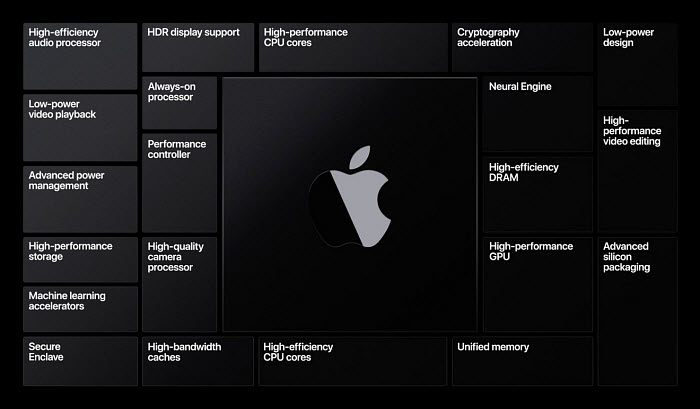Apple is ditching Intel's X86 chips in Macs for Apple's own processors based on ARM architectures – the same technology used in Apple iPhone and iPad. However, this doesn't mean the transition will happen overnight. The company will complete the transition in about two years. During the years to come, it will ship new Macs with Apple silicon and continue to release Intel-based Macs. This makes customers confused. Which is better, ARM or Intel Mac? In this article, we'll have a detailed review on ARM vs Intel X86 Processors differences.
Why Apple Moves Macs from Intel to ARM, and what Benefits You Get?
Performance
One of the biggest advantage of AMR CPUs over X86 CPUs is power efficiency. Described by the company as "the highest performance with the lowest power consumption", ARM chips have far less "baggage" than X86 processors. ARM Macs will get a whole custom SoC, with a series of features unique to Mac. This gives ARM Macs "industry-leading performance per watt and higher performance GPUs", enabling developers to write more powerful and high-end apps and games. Compared to Intel processor, ARM CPU also supports technologies such as Neural Engine to make ARM Mac a good choice for machine learning.
Apple has also illustrated how powerful ARM chip is:
- Microsoft Office, Adobe Photoshop, and Lightroom running smoothly, with a 5GB Photoshop PSD running with smooth animations
- Three streams of simultaneous 4K Pro Res video in Final Cut Pro
- Rotating around a photorealistic stone face in Cinema 4D
- Rotating around a 6-million polygon scene in Autodesk's Maya animation studio, with textures and shaders on top
- Rendering effects in the Unity game engine
- The games Shadow of the Tomb Raider and Dirt: Rally running on Mac smoothly (but at low resolution and detail)

App compatibility
Apple's transition from Intel CPU X86 to ARM processor also means that iPhone and iPad apps can run natively on ARM-powered Macs. As iDevices now has the same Apple silicon as the ARM Macs, the apps can run natively on Mac without any modification. This is a unique advantage of ARM Macs over Intel x86 chips. Through the new version Rosetta 2 app in macOS Big Sur, the existing Intel X86 apps can be translated for ARM Macs on the fly. For apps that run both on Intel-based Macs and ARM-based Macs, Apple releases a new format called Universal 2 to package both codecbases together.
Meanwhile, Apple will introduce a set of virtualization tools to run Linux and Docker on an ARM Mac.
Developer friendly
Compared to Intel X86 processor, AMR Mac is much friendlier to developers. The common ARM-based architecture across Apple's products should now let developers write and optimize apps across every major Apple device easier than ever. For Intel Mac apps developers, they have to code separate apps for iDevices. That requires a lot of development effort. Different to Intel, ARM Mac app developers only need to code a UI that is suitable for mobile UI, then they can issue the apps for iPhone and iPad.
Apple launches a Quick Start program with access to documentation, sample code, and beta versions of macOS Big Sur and Xcode 12. There is also a developer transition kit (DTK) which consists of a Mac mini, shipped with Apple's A12Z Bionic SoC, 16GB of RAM and a 512GB SSD.
Verdict: Should I Buy ARM or X86 Mac?
In short, the transition from Intel X86 to ARM processor in Mac is a win-win-win move. For apple, the shift to Apple's own ARM-based chips gives the firm even greater control over the its hardware and software; for developers, the common architecture across all Apple products makes it easier to code apps for Mac, iPhone, and iPad; for consumers, they will get more powerful hardware with a longer battery life on ARM Mac than Intel-based Macs.
Now comes to the question: should I wait or buy an ARM or Intel X86 Mac? Now let me answer you that:
- If you're a developer of Apple apps, ARM Mac is a must have;
- If you want to play the games and use the apps across iDevices and the Mac, choose ARM MAC;
- If you want a better performance of heavy apps like Final Cut Pro, Adobe, etc. on a Mac, select ARM over Intel;
- If you want to longer battery life, get a ARM Mac....
Besides any reason like those mentioned above, Intel X86 Mac is still a powerful tool. You'll also need to consider the errors in ecosystem, compatibility, performance, etc. during ARM Mac's early stage.








